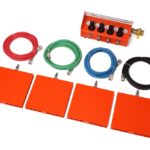The hydraulic system may be considered one of the most important aspects of a given aircraft, serving to provide pilots the power needed to manage the various flight surfaces and controls of the vehicle. From the adjustment of flight surfaces that affect aerodynamics to the operation of the brakes of an aircraft, there are many sections of the vehicle that require the use of hydraulics to optimally function. To best understand the importance of the aircraft hydraulic system, one should first familiarize themselves with the functionality of the hydraulics and how they are employed for aviation.
In the earliest days of powered flight, control over various aircraft systems was provided by mechanical aircraft cables and wires that formed linkages to the cockpit. As a simple, yet robust, control system, movements made by the pilot would directly result in the actuation of various surfaces, equipment, and components. Despite the reliability of such mechanical systems, the continued advancement of aircraft and their increased sizes quickly lead to an issue of pilots being unable to achieve the force necessary to control surfaces that weigh hundreds or thousands of pounds. As such, the complexity of such aircraft required a solution for pilots to overcome the limitations of their strength.
The solution to this problem came in the form of the aircraft hydraulic system, that of which functions on a fairly basic operating principle. Hydraulic systems may vary based on their design, though the most common components are the reservoir, hydraulic pump, electric motor, and hydraulic cylinder. To actuate a processor to provide the force required by control, the system will pump fluids to various sections within an enclosed space. As fluid passes through valves and into cylinders, the incompressible nature of fluids results in the transformation of hydraulic energy to mechanical energy. This allows for a large amount of force to be generated, and valves serve to relieve pressure as needed to return to a previous or different state.
When applied to a typical aircraft and its various systems and parts, the pilot will activate a control from the cockpit and the flight computer will generate instructions for a particular system. As the computer communicates with other components, the pump will begin to push hydraulic fluid throughout the system, creating the force necessary to carry out a command. While the complexity and controls of a particular aircraft may vary by model, many systems commonly rely on hydraulics for their operations.
Flight controls are paramount to safe operations, and hydraulics serve for the creation of force needed for actuation. Rather than require large amounts of force on behalf of the pilot, the management of systems is achievable through simple flight deck controls. As little force is required for flight management, some controls will be specifically designed to be weighted so that the range of movement is not adjusted too rapidly. Slats, flaps, wing spoilers, and other surfaces are also controlled by hydraulics due to their immense weight. Similar to flight controls, management is provided from the flight deck and pilots may send commands to adjust all aircraft components as needed.
Beyond such examples, several other systems and surfaces may be operated with hydraulics as well. With the power of incompressible fluid systems, pilots may assume control over the ram air turbine, thrust reverser, landing gear, nose gear steering system, brake unit, and much more. As the aircraft hydraulic system is paramount to the efficient operation of countless aircraft components and systems, they must be well maintained to avoid any pressure losses, leaks, or damage.
Whether you are searching for aircraft part suppliers or parts for flight computers, gear doors, airplane propeller systems, aircraft wheels, rudder pedal systems, and more, Dynaron Enterprise has you covered with our unrivaled inventory and offerings. Dynaron is a trusted distributor of high-quality aircraft components that have been sourced from top global manufacturers.







